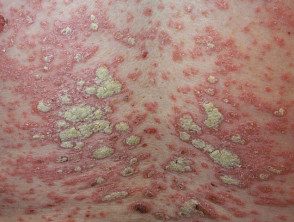What is the innate immune response?
The innate immune response refers to the parts of the immune system that are immediately functional. It includes:
- Physical barriers such as the tight junctions between the cells of the epithelium and the mucociliary layer that covers the epithelium in the respiratory, gastrointestinal, and genitourinary tracts.
- White blood cells that identify and eliminate pathogens not specifically
- Membrane-bound receptors and intracellular proteins, such as inflammasomes, that bind and eliminate invasion microbes through a cascade of signals [1].
What is an inflammasome?
An inflammasome is part of the innate immune system. It is an intracellular complex that binds microbes and creates a cascade of signals to attack them.
Inflammasomes include [2]:
- the nucleotidebinding oligomerization domain (NOD) receiver (NLR) P3 inflammasome
- The absent in melanoma 2 (AIM2) inflammasome
- The NLRC4 inflammasome
- The pirin inflammasoma.
An inflammasome consists of [3]:
- A molecular pattern recognition receptor (PRR)
- A apoptosisSpeck-like protein associated with a caspase recruitment domain (ASC) adapter protein
- A caspase-1 enzyme.
Inflammaomas regulate the immune answer to exogenous stimuli (eg. bacteria) and endogenous stimuli (eg. neoplasm) through cytokine discharge, particularly interleukin (IL) -1β and IL-18, and induce neutrophils recruitment [4].
Inflammaomas also play an important role in acute and chronic inflammatory diseases [4].
What is an inflammatory skin disease?
Inflammatory skin diseases are characterized by activation of the innate and adaptive immune system through the production of proinflammatory drugs. cytokines [4]. They are classified as autoimmune diseases and autoinflammatory syndromes or diseases.
Autoimmune inflammatory skin diseases such as vitiligo and lupus erythematosus involve aberrant responses to autoantigenscontrolled by B cells and T cells, With the presence of autoantibodies.
Autoinflammatory skin diseases like periodic ones fever syndromes and neutrophilic skin disease involve the activation of cells of the innate immune system (macrophages, neutrophils, mast cells and natural killer [NK] cells), resulting in tissue damage in the absence of autoantigens and autoantibodies.
Some skin diseases like psoriasis have autoimmune and autoinflammatory components. [4].
We use the examples of allergic contact. dermatitis and psoriasis to illustrate the role of inflammasomes in chronic inflammatory skin diseases.
Skin conditions in which inflammasomes are present.

Allergic contact dermatitis

Chronic plaque psoriasis

Acute neutrophilic dermatosis.
Inflammasomes in allergic contact dermatitis.
Allergic contact dermatitis is a erythematous, pruritus eruption caused by a delay hypersensitivity reaction to a small molecule [5].
In experimental contact dermatitis due to 2,4-dinitrofluorobenzene (DNFB), preparation of the adaptive immune system has been shown to depend on activation of the innate immune system. [5].
The evidence behind the inflammasome-mediated production of IL-1 family cytokines in contact dermatitis is as follows:
- The key components of the inflammasome are present in keratinocytes [6].
- Exposure to DNFB produces the secretion of IL-1β in animal models [6].
- IL1 receptor antagonists (IL-1RA) have therapeutic effects in contact dermatitis [4].
Inflammasomes in psoriasis
Psoriasis is a common skin condition characterized by circumscribed erythematous plates covered with a silver scale.
the pathophysiology psoriasis is complex; it involves neutrophils and the innate immune response [7].
- Innate immune cells activate T helper (Th) -1 and Th-17 lymphocytes, which release inflammatory cytokines such as IL-1β and IL-18 [8,9].
- IL-1β and IL-18 are up-regulated through caspase-1 and AIM-2 in keratinocytes [8,10].
- These inflammatory cytokines result in increased recruitment of immune cells, keratinocytes proliferationand sustained inflammation [8].
Antagonists of members of the IL-1 family are under investigation for the treatment of psoriasis. [two].
What is an autoinflammatory disease?
Autoinflammatory syndromes and diseases are characterized by multiple inflammatory episodes caused by an exaggerated innate immune response. the Pathogenesis it does not involve autoantibodies and specific T cells.
An autoinflammatory disease is diagnosed after excluding infectious, neoplastic and allergic conditions.
Autoinflammatory syndromes include hereditary periodic fever syndromes, others monogenic autoinflammatory syndromes, non-inherited or polygenic disorders (such as generalized pustular psoriasis) and neutrophilic dermatoses.
Inflammasomes in autoinflammatory skin disease.
Inflamlamomas upregulate the signaling of various cytokines (including IL-1) in autoinflammatory skin diseases, which in turn amplify neutrophil-mediated inflammation through multiple mechanisms. IL-1β has antiapoptotic effects on neutrophils, prolonging their survival.
- The assembly of the inflammasome begins with the recognition of stimuli by PPR receptors, which interact with the ASC molecule and activate caspase-1 [5].
- Caspase-1 activates IL-1β and IL18, which stimulate the inflammatory response [5].
- Proinflammatory cytokines activate neutrophils, which infiltrate the skin and other organs, resulting in specific skin symptoms such as pustules, ulceration or rash, and systemic symptoms like low fever and discomfort.
